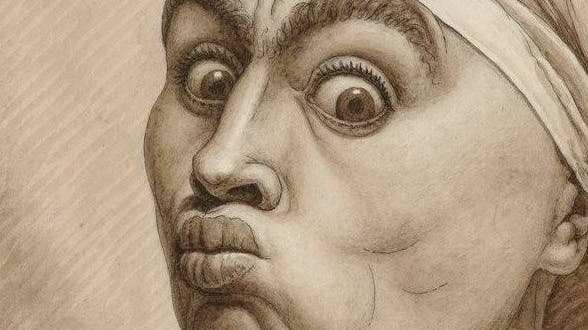Islands and masonic initiations: the fantastic architecture of Jean-Jacques Lequeu
It's got a flaming river in it!
What do you know about Jean-Jacques Lequeu? I'd be surprised if you know anything because he's quite obscure. A rare find. He was French architect who lived through the Revolution only to die in poverty having never found fame. Almost nothing he drew was ever made but by bequeathing 800 drawings to the Bibliothèque nationale de France, he ensured his ideas would not be forgotten. And I'm glad they haven't been.
Lequeu doesnt' seem to have been bound by reality, which is an unusual trait for an architect. He plotted grand designs as if in the knowledge they would never be made. Take 'The Island of Love and Fisherman's Rest' for example: it is an island - who designs an island?! Bond villains not included. Yet there it is, in Lequeu's unerringly precise pencil work and ink, neat and crisp, as if actually it does exist somewhere and he is merely replicating it.
Do you know how many different kinds of animals Lequeu imagined living there? Quite a few, according to an online Morgan Library & Museum tour. There were to be lions, tigers, leopards, lynxes, foxes, otters, sable, tamarins, armadillos - even god damn unicorns. We know this because of the copious amounts of notes on the picture - another feature of his architectural work. It's as though he couldn't leave the exact functions or stories of the designs to chance. The purpose of the floating island? To give people a place for quiet repose from the two large military encampments either side of it (although quite how much peace they'd get with all those animals running around, I don't know).
Or consider the secret masonic initiation base Lequeu designed. It has an entrance hidden behind a statue (Bond villains again!) and great subterranean chambers themed around air, water and fire elements. These chambers would house trials which would push initiates close to death. Some even had complex mechanisms which could produce peals of thunder. Whichever of the initiates could survive the dark and emerge into the light would be welcomed into the Society of Sages and Most Courageous Men.
Or consider the elaborate tomb Lequeu designed for king Lars Posena, pointed out by culture writer Allison C. Meier on Twitter. Posena was an Etruscan king who died thousands of years ago, which makes him a poor choice of patron I have to say. Not only is his tomb improbably designed, made up of cones holding a huge globe, holding something even larger on top - all precariously piled - but it has an inescapable labyrinth underneath!
Think about that for a moment: an inescapable labyrinth. How is that even possible? Yet there it is, along with an annotated compendium of the most famous labyrinths in history. Are you beginning to see what I mean?
There's more: a Temple of Divination for which Lequeu included a recipe for sweet perfume, so as to mask the smell of sulfur coming from the flaming river running into it. A hunting lodge mounted with the heads of dogs, boars and deers, which had stones that smelt of cat wee. The spherical Temple of the Earth (formerly the Temple of Supreme Wisdom) which had walls of stars inside. A cattle barn in the shape of a giant bull. Even, according to a report of the exhibition by studio international, an "Indian-inflected glass pleasure pavilion to be sunk underwater and accessed only through secret passages". The list goes on and on. Imagine seeing all that in Grand Designs - poor old Kevin McCloud would pop.
But these aren't the works of reality, not one we are aware of anyway. Lequeu, according to the Morgan Library & Museum tour, invented entire realms of his own. In one drawing there's an aerial view of a countryside, and it looks entirely ordinary until you realise the countryside in question doesn't exist anywhere but in his mind. It's as if these pictures are windows showing us plainly what he sees inside: "Look, there."
I tell you, it's a crying shame Lequeu isn't around today. Not only because he'd live in a society more open to the ideas he had, but because today, he would have the tools to actually take us there, to the realms of his mind. Imagine that! Imagine actually going into the masonic initiation base and trying to survive the chambers to emerge into the light. Imagine walking around the floating island with the impossibly exotic menagerie. And behind it all, the omnipotent, omniscient architect. The man glimpsed pulling faces in self-portraits, the man who painted naughty erotic pictures, like the nun flashing a breast.
It's frustrating not being able to see more - of his work, not the nun! But as I'm in the UK and the exhibitions are in America, there's not a lot I can realistically do. All I can see are snippets and what exhibition visitors decide to relay, which makes me wonder how much more there is - both in the exhibition and the much larger pile of 800 drawings bequeathed. How many other windows are there I might look through to see into Lequeu's mind?
But perhaps it's better this way. Perhaps my imagination is fired more strongly for not being able to get there, because in my imagination there's no limit to what might be. Reality is not - as it wasn't in Lequeu's worlds - invited.


